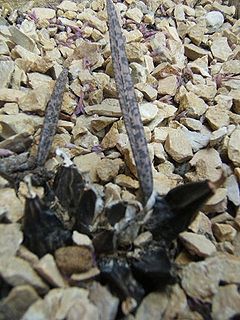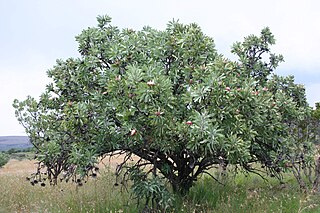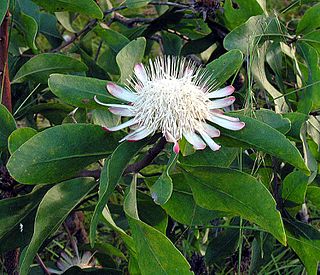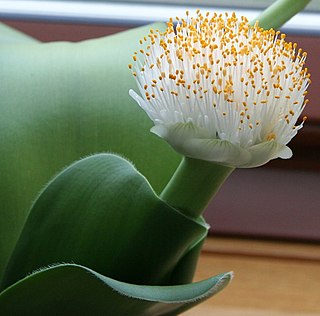
Eulophia, commonly known as corduroy orchids, is a genus of about two hundred species of flowering plants in the orchid family, Orchidaceae. Most Eulophia orchids are terrestrial but some are deciduous while others are evergreen. They either have an underground rhizome or pseudobulbs on the surface and those species with leaves have them on the end of a fleshy stem. The flowers are arranged on a thin flowering spike, the flowers having sepals which are larger than the petals. The genus is widely distributed but most species are found in Africa and Asia, usually growing in shady places with grass or shrubs in forests.

Oeceoclades decaryana is a terrestrial orchid species of the genus Oeceoclades that is native throughout southern and southeastern Africa. It can be found growing in Kenya, Mozambique, Zimbabwe, Madagascar, and KwaZulu-Natal in South Africa. It was first described by the French botanist Joseph Marie Henry Alfred Perrier de la Bâthie in 1935 as a species in the genus Eulophia. He later transferred this species to the genus Lissochilus in 1941, followed by another transfer to the genus Eulophidium in 1957 by the English botanist V.S. Summerhayes in 1957. When Leslie Andrew Garay and Peter Taylor revised the genus Oeceoclades in 1976, they transferred this species to the expanded Oeceoclades.

Protea caffra, native to South Africa, is a small tree or shrub which occurs in open or wooded grassland, usually on rocky ridges. Its leaves are leathery and hairless. The flower head is solitary or in clusters of 3 or 4 with the involucral bracts a pale red, pink or cream colour. The fruit is a densely hairy nut. The species is highly variable and has several subspecies.

Protea gaguedi is a species of tree which belongs to the genus Protea.

Protea welwitschii is a species of shrub or small tree which belongs to the genus Protea, and which occurs in bushveld and different types of grassland.

Haemanthus is a Southern African genus of flowering plants in the family Amaryllidaceae, subfamily Amaryllidoideae. Members of the genus are known as blood lily and paintbrush lily. There are some 22 known species, native to South Africa, Botswana, Namibia, Lesotho and Swaziland. About 15 species occur in the winter rainfall region of Namaqualand and the Western Cape, the remainder being found in the summer rainfall region, with one species Haemanthus albiflos occurring in both regions.

Protea comptonii, also known as saddleback sugarbush, is a smallish tree of the genus Protea in the family Proteaceae. It is found in South Africa and Eswatini.

Eulophia guineensis is a species of orchid. It is the type species of the genus Eulophia and is commonly known as the Guinea Eulophia or the broad-Leaved ground orchid. It is found in the Cape Verde Islands, much of tropical Africa and part of the Arabian Peninsula. It is a terrestrial orchid that can grow to a metre or so tall, and is found in lowland and upland woods and scrubland.

Eulophia pulchra, commonly known as the gonzo orchid, is a plant in the orchid family and is native to areas from Tanzania and Mozambique to the Western Pacific Ocean. It is a terrestrial orchid with crowded, above-ground pseudobulbs, two or three leaves and pale yellowish green flowers with dull purple or red markings. It grows in plant litter in rainforests.

Eulophia speciosa is a species of terrestrial orchid found from Ethiopia to South Africa and in Yemen and Saudi Arabia. The plants usually grow in grasslands in sandy soils or in clay.
Eulophia meleagris is an orchid species in the genus Eulophia found in East Cape Province to KwaZulu-Natal in South Africa.

Albizia adianthifolia is a tree in the family Fabaceae. It is commonly known as the flat-crown. Its range extends from eastern South Africa to Tropical Africa.

Areas of forest which grow in KwaZulu-Natal, South Africa mostly on south facing slopes in higher rainfall areas, and along the humid coastal areas. Different types of forest can be identified by their species composition which depends mostly on the altitude, latitude and substrate in which they grow. South facing slopes are favourable for the development of forest as they are more shaded, and therefore cooler and retain more moisture than the northern slopes. The extra moisture on the south slopes is not only favoured by forest trees, but also helps to prevent or subdue wildfires. Fires can also be blocked by cliff faces and rocks or boulders on these slopes, and by streams or rivers at the base of the slopes. The coastal regions are conducive to forest formation, because of high rainfall and humidity which are favoured by forest trees and also help to prevent or subdue fires. The rivers of the coastal areas are also broader than further inland, which may often prevent fires from spreading long distances, and fires generally burn uphill and therefore more often away from areas at low altitude.

The Maputaland-Pondoland-Albany Hotspot (MPA) is a biodiversity hotspot, a biogeographic region with significant levels of biodiversity, in Southern Africa. It is situated near the south-eastern coast of Africa, occupying an area between the Great Escarpment and the Indian Ocean. The area is named after Maputaland, Pondoland and Albany. It stretches from the Albany Centre of Plant Endemism in the Eastern Cape Province of South Africa, through the Pondoland Centre of Plant Endemism and KwaZulu-Natal Province, the eastern side of Eswatini and into southern Mozambique and Mpumalanga. The Maputaland Centre of Plant Endemism is contained in northern KwaZulu-Natal and southern Mozambique.

Isoglossa woodii, commonly known as buckweed, is a monocarpic shrub of the family Acanthaceae, growing up to 4 m tall. It grows in colonies in coastal forest areas of KwaZulu-Natal and marginally into Eastern Cape, South Africa.

Deinbollia oblongifolia is a shrub or small tree in the family Sapindaceae. It is commonly known as the dune soap-berry and is found in coastal vegetation from the Eastern Cape of South Africa, through KwaZulu-Natal to southern Mozambique and Swaziland. It is named after Peter Vogelius Deinboll (1783-1876), a Danish botanist and plant collector.

Eulophia petersii is a succulent species of flowering plant in the family Orchidaceae, from southern and eastern Africa.

Capparis fascicularis, the zigzag caper-bush, is a plant in the Capparaceae family and is native to Africa.

Erianthemum dregei is a species of parasitic plant in the family Loranthaceae, and is commonly known as the hairy mistletoe or wood flower.
Protea nubigena, commonly known as cloud sugarbush, is a very rare species of a flowering shrub belonging to the Protea genus. It is endemic to KwaZulu-Natal, South Africa and is found in the uKhahlamba Basalt Grassland within the Royal Natal National Park, near Mont-Aux-Sources, at an altitude of about 2,250 metres (7,380 ft) in well-drained, humus-rich soil on shaded slopes.


















